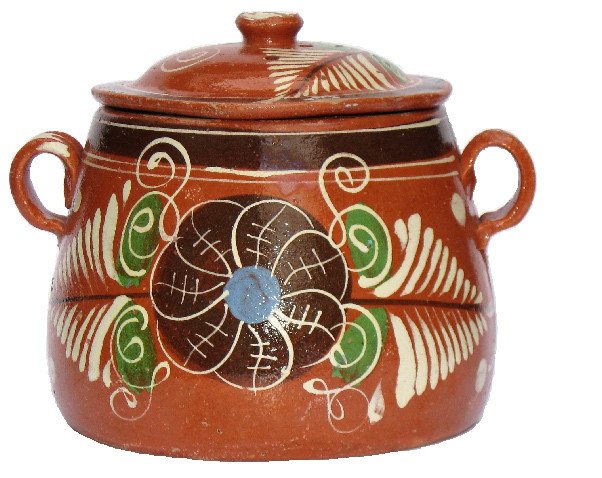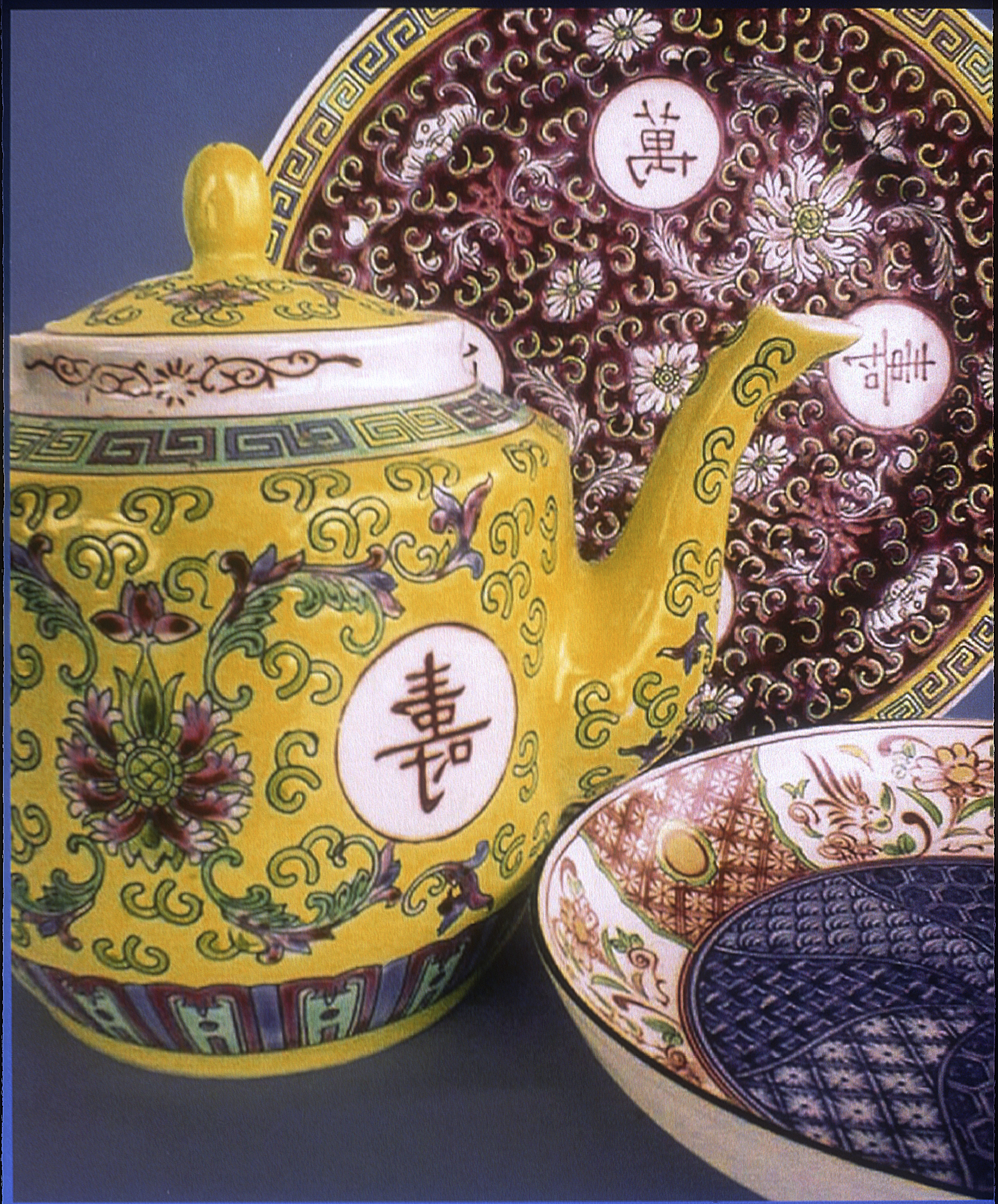Talking Points for Educating At-Risk Groups About Lead in Tableware
Introduction
(Visite esta página en Español)
Introduction
The greatest hazard of lead poisoning from tableware today lies in the use of imported products used by certain ethnic communities rather than commercial china and dishes. For example:
Latin American folk terra cotta pottery, primarily from Mexico, is especially dangerous because of its high lead content and everyday uses that enhance lead leaching (cooking, storage of food/drink, use with acidic foods). It can leach significant amounts of lead and has been documented as a source of lead poisoning in Latino children in California.*
Another potential source of lead exposure are certain highly decorated traditional dishes used in some Asian communities. Some styles of these dishes, such as the "Long Life/Four Seasons" pattern, have been used for centuries.
It is important that tailored education and outreach be provided to Latino and Asian communities to prevent their exposure to lead from this tableware. These "talking points" are guidelines to assist health educators in incorporating information on tableware into their presentations on lead to these groups.
Note to educators: Information about lead in tableware should always be given within the context of the general problem of lead. Some general points about lead are included. Please feel free to use other lead education materials to complement this outline. Additional materials for working with at-risk communities are contained in the sections Educational Materials for Latino/Spanish-Speaking Audiences and Educational Materials for Asian/Pacific Island Audiences.
* California Department of Public Health, Childhood Lead Poisoning Prevention Branch, Care Management and Surveillance Section.
General Lead Information
Why should people be concerned about lead?
- It is a toxic substance that is particularly harmful to children and unborn babies.
- Lead can damage a child's brain. Lead poisoning can make it hard for children to learn, pay attention, and behave. Some of the damage done by lead is irreversible.
- Children with lead poisoning do not always look or act sick or have symptoms readily associated with lead. The only way to find out if a child is exposed is to have her/him tested for lead.
- Lead can also cause serious health and reproductive problems in adults.
Sources of lead exposure other than tableware
- For most people, tableware is not the main source of lead exposure.
- Tableware can be one of a number of sources of lead exposure.
- Other important sources of lead are old paint, soil, certain home remedies, house dust, some mini-blinds, and workplaces where lead is used.
Lead in Tableware
How lead gets from tableware into the body
- Lead is used in the glazes or decorations covering the surface of some ceramic dishes.
- This lead can get into the food or drink that has been prepared, stored, or served in the dishes. It enters the body when the food or drink is consumed.
How to spot tableware that may have hazardous amounts of lead
Some characteristics associated with risk of lead exposure in tableware include:
- Rustic terra cotta pottery with a clear or colored glaze;
- Rough, imperfect glaze; glaze that is coming off or damaged;
- Decoration or decal on top of the glaze;
- Bright colors or decoration on the food-bearing part of the dish.
- You can't always tell by looking at a dish whether it contains lead or will expose you to lead. The only way to know for sure is to test the dish or pot for lead.
Tableware that contains high levels of lead is used in certain communities
- Latin American folk terra cotta, especially that from Mexico, has been shown to expose its users to significant amounts of lead.
- Although less of a problem, certain highly decorated traditional Asian dishes also expose people to lead when used with food.
Uses which increase the chance that lead will leach from tableware into food
- Cooking or microwaving food or drink in lead-bearing tableware.
- Serving acidic foods in lead-bearing tableware. Acidic foods include citrus fruits, tomatoes, alcohol, soy sauce, coffee, etc.
- Storing food in leaded containers.
- If you don't know whether a dish, pot, cup, or bowl contains lead, don't use it with food or drink.
Dealing with issues that arise around treasured family or cultural pieces
- Acknowledge the personal, cultural, historical, and culinary importance of cookware and tableware used by specific communities.
- Often these have been used in families for years, are beautiful and prized for their cultural significance, and are considered to have unique qualities for food preparation (particularly the Latin American terra cotta).
- Suggest that prized traditional/family pieces be used for decoration or plants rather than for preparing and serving food.
Latino Audiences
Lead in Latin American dishes
- There have been serious cases of lead poisoning in Latino children who ate food prepared or stored in glazed Mexican terra cotta.
- Almost all folk terra cotta from Latin America contains heavily leaded glazes. This terra cotta pottery is collectively referred to as ollas de barro.
- The most common pieces are:

- Ollas - deep pots for cooking beans that often have a lid or are used covered
- Cazuelas - wide, shallow, open pots used for cooking moles, stews, meat dishes, and rice
- Jarros - pitchers used for storing and serving juices and other drinks
- Cántaros - large water containers. Not all cántaros are glazed. Those that are not glazed are not a lead hazard.
The danger of lead leaching into food from glazed terra cotta cookware or tableware can be very great because:
- It is used to cook beans, rice, mole, etc.;
- It is used to store food and drink, such as beans or fruit juice drinks;
- It is used to serve foods;
- It is often used with acidic foods, such as salsa or fruit juice.
Reaction from the audience
People often feel these dishes and pots have special qualities. Acknowledge that the special qualities are true. They include:
- Imparting sweetness or special flavors to food such as beans;
- Making rice come out loose, not sticky;
- Distributing heat better when cooking;
- Preventing food from sticking to the pot.
Alternatives
- Suggest alternative cookware and serving dishes, such as cast iron, stainless steel, heatproof glass (such as Pyrex), or ceramic cookware (such as Corning Ware).
- Remind audience that cooking in cast iron also provides extra iron for their family's diet. Iron is a nutrient that is important in preventing lead poisoning.
Asian-Pacific Islander Audiences
Lead in Asian dishes 
- Some traditional dishes, often made in China, contain high levels of lead in the paint, glaze or decorations.
- The most common dishes are those with the Long Life/Four Seasons pattern.
- The characteristics most associated with lead in these dishes are decoration on top of the glaze, or a rough, chalky feel on the surface of the piece.
- These traditional dishes are often treasured and used on special occasions.
- The picture to the right is an example of these types of dishes.
Acidic Asian foods
Some popular foods served in Asian communities are acidic so they leach lead more readily. It is particularly hazardous to:
- Serve vinegar, soy, or chili sauce in leaded dipping dishes;
- Serve acidic foods (such as pickled foods) in leaded bowls;
- Serve tea in leaded cups.
Alternatives
- Not all manufacturers use lead in dishes. Dishes with the same pattern made by two different manufacturers may contain lead in one case but not in another. The only way to know for sure if the dishes contain lead is to test them.
- Some traditional patterns do not contain lead. Give examples of patterns that do not contain lead, like the rice pattern.
- Replicas of the traditional patterns are often available in plastic for everyday use.
Note to educators: Bring samples of both leaded and lead-free alternatives such as the rice pattern and plastic replicas to show the audience.